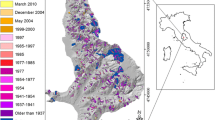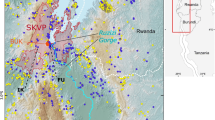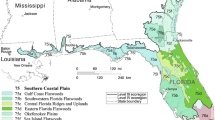Abstract
Landslides often happen where they have already occurred in the past. The potential of landslides to reduce or enhance conditions for further landsliding has long been recognized and has often been reported, but the mechanisms and spatial and temporal scales of these processes have previously received little specific attention. Despite a preponderance of qualitative and anecdotal evidence, analysis has been limited. As a result, there is little consensus on the meaning of terms such as landslide repetition, recurrence, and reactivation. This source of confusion is evident when such terms are also used to describe systems where landsliding is prevalent but unrelated to landslide history. Recent findings, partly based on a rare multi-temporal landslide inventory for an area in Italy, show that the impacts of earlier landslides affect a substantial fraction of landslides, that landslides following earlier landslides differ from those that do not, and that accounting for the effect of previous landslides can improve susceptibility assessments. These findings await confirmation in other landslide-prone landscapes but show that consecutive landsliding deserves more attention, which requires consistent terminology. No such terminology is presently available, and we therefore propose it in this manuscript. We use the term “uncorrelated landsliding” to describe situations where landslides are common, but where a correlation with environmental variables such as terrain steepness is not implied. We propose “correlated landsliding” to describe situations where landslides are common and correlations with environmental variables exist, and “path-dependent landsliding” to describe situations where causal relations exist between consecutive landslides, for instance, when landslides occur at the scarp of previous landslides. These are situations where past landslides impact future landslides. Within the path-dependent category, we distinguish three subcategories based on the spatial distance between earlier and later landslides: “reactivation” or “continuation” if essentially the same material recommences or continues to slide, “local activation” if an earlier slide causes changes in a local hillslope that cause a later slide, and “remote activation” if an earlier slide causes changes elsewhere in the landscape that cause a later landslide. We use this proposed set of terms to outline some prominent knowledge gaps and potential research questions.





Similar content being viewed by others
References
Alvioli M, Marchesini I, Reichenbach P, Rossi M, Ardizzone F, Fiorucci F, Guzzetti F (2016) Automatic delineation of geomorphological slope units with <tt>r.slopeunits v1.0</tt> and their optimization for landslide susceptibility modeling. Geosci Model Dev 9:3975–3991. https://doi.org/10.5194/gmd-9-3975-2016
Baum RL, Reid ME (2000) Groundwater isolation by low-permeability clays in landslide shear zones. In: Bromhead E, Dixon N, Ibsen M (eds) Landslides in Research, Theory and Practice. Proceedings of the 8th International Symposium on Landslide. Thomas Telford, London, p 139–144
Bennett GL, Roering JJ, Mackey BH, Handwerger AL, Schmidt DA, Guillod BP (2016) Historic drought puts the brakes on earthflows in Northern California. Geophys Res Lett 43:5725–5731. https://doi.org/10.1002/2016GL068378
Collins BD, Reid ME (2019) Enhanced landslide mobility by basal liquefaction: the 2014 State Route 530 (Oso), Washington, landslide. GSA Bull. https://doi.org/10.1130/B35146.1
Crandell, D.R., Fahnestock, R.K., 1965. Rockfalls and avalanches from Little Tahoma Peak on Mount Rainier, Washington, Bulletin https://doi.org/10.3133/b1221A
Crandell DR, Varnes DJ (1961) Movement of the slumgullion earthflow near Lake City, Colorado. In: Short Papers in the Geologic and Hydrologic Sciences, pp B136–B139
Cruden DM, Varnes DJ (1996) Chapter 3: landslide types and processes. In: Turner A, Schuster R (eds) landslide: investigation and mitigation. National Academy Press, pp 36–75
Dietze M (2018) The R package “eseis”–a software toolbox for environmental seismology. Earth Surf Dyn 6:669–686. https://doi.org/10.5194/esurf-6-669-2018
Dupree HK, Taucher GJ, Voight B (1979) Bighorn Reservoir Slides, Montana, U.S.A. Dev Geotech Eng 14:247–267. https://doi.org/10.1016/B978-0-444-41508-0.50014-4
Fleming, R.L., Baum, R.L., 1999. Map and description of the active part of the Slumgullion landslide, Hinsdale County, Colorado
Fuchs S, Röthlisberger V, Thaler T, Zischg A, Keiler M (2017) Natural hazard management from a coevolutionary perspective: exposure and policy response in the European Alps. Ann Am Assoc Geogr 107:382–392. https://doi.org/10.1080/24694452.2016.1235494
Galli M, Ardizzone F, Cardinali M, Guzzetti F, Reichenbach P (2008) Comparing landslide inventory maps. Geomorphology 94:268–289. https://doi.org/10.1016/j.geomorph.2006.09.023
Galve JP, Gutiérrez F, Cendrero A, Remondo J, Bonachea J, Guerrero J, Lucha P (2009) Predicting sinkholes by means of probabilistic models. Q J Eng Geol Hydrogeol 42:139–144. https://doi.org/10.1144/1470-9236/08-039
Galve JP, Remondo J, Gutiérrez F (2011) Improving sinkhole hazard models incorporating magnitude-frequency relationships and nearest neighbor analysis. Geomorphology 134:157–170. https://doi.org/10.1016/j.geomorph.2011.05.020
Guerriero L, Revellino P, Coe JA, Focareta M, Grelle G, Albanese V, Corazza A, Guadagno FM (2013) Multi-temporal maps of the Montaguto earth flow in Southern Italy from 1954 to 2010. J Maps 9:135–145. https://doi.org/10.1080/17445647.2013.765812
Guzzetti F, Galli M, Reichenbach P, Ardizzone F, Cardinali M (2006) Landslide hazard assessment in the Collazzone area, Umbria, central Italy. Nat Hazards Earth Syst Sci 6:115–131. https://doi.org/10.5194/nhess-6-115-2006
Haase P (1995) Spatial pattern analysis in ecology based on Ripley’s K-function: introduction and methods of edge correction. J Veg Sci 6:575–582. https://doi.org/10.2307/3236356
Heim A (1932) Bergsturz und Menschenleben. Fretz & Wasmuth, Zurich
Hengl T, Reuter HI (2009) Geomorphometry: concepts, software, applications. Dev Soil Sci 33:772
Hungr O, Leroueil S, Picarelli L (2014) The Varnes classification of landslide types, an update. Landslides 11:167–194. https://doi.org/10.1007/s10346-013-0436-y
Hutchinson JN, Bhandari RK (1971) Undrained loading, a fundamental mechanism of mudflows and other mass movements. Géotechnique 21:353–358. https://doi.org/10.1680/geot.1971.21.4.353
Iverson RM, George DL, Allstadt K, Reid ME, Collins BD, Vallance JW, Schilling SP, Godt JW, Cannon CM, Magirl CS, Baum RL, Coe JA, Schulz WH, Bower JB (2015) Landslide mobility and hazards: implications of the 2014 Oso disaster. Earth Planet Sci Lett 412:197–208. https://doi.org/10.1016/J.EPSL.2014.12.020
Jansen RB (1988) Advanced dam engineering for design, construction, and rehabilitation. Van Nostrand Reinhold. https://doi.org/10.1007/978-1-4613-0857-7
Jones FO, Embody DR, Peterson WL, Hazlewood RM (1961) Landslides along the Columbia River valley, northeastern Washington, with a section on seismic surveys. Professional Paper. https://doi.org/10.3133/PP367
Keller B (2017) Massive rock slope failure in Central Switzerland: history, geologic–geomorphological predisposition, types and triggers, and resulting risks. Landslides 14:1633–1653. https://doi.org/10.1007/s10346-017-0803-1
Korup O, Crozier M (2002) Landslide types and geomorphic impact on river channels, Southern Alps, New Zealand. In: Rybar J, Stemberk J, Wagner P (eds) Landslides. Swets & Zeitlinger, Lisse, pp 233–238
Korup O, Wang G (2015) Multiple landslide-damming episodes. Landslide Hazards, Risks and Disasters:241–261. https://doi.org/10.1016/B978-0-12-396452-6.00008-2
Lombardo L, Bakka H, Tanyas H, Westen C, Mai PM, Huser R (2019) Geostatistical modeling to capture seismic-shaking patterns from earthquake-induced landslides. J Geophys Res Earth Surf 124:1958–1980. https://doi.org/10.1029/2019JF005056
Lynch HJ, Moorcroft PR (2008) A spatiotemporal Ripley’s K-function to analyze interactions between spruce budworm and fire in British Columbia, Canada. Can J For Res 38:3112–3119. https://doi.org/10.1139/X08-143
Malamud BD, Turcotte DL, Guzzetti F, Reichenbach P (2004) Landslide inventories and their statistical properties. Earth Surf. Process. Landforms 29:687–711. https://doi.org/10.1002/esp.1064
Marc O, Hovius N, Meunier P, Uchida T, Hayashi S (2015) Transient changes of landslide rates after earthquakes. Geology 43:883–886. https://doi.org/10.1130/G36961.1
Meyer JH (1806) Der Bergfall Bey Goldau Im Canton Schwyz, Am Abend Des Zweyten Herbstmonats 1806. Orell, Fussli and company, Zurich
Minasny B, Finke P, Stockmann U, Vanwalleghem T, McBratney AB (2015) Resolving the integral connection between pedogenesis and landscape evolution. Earth-Science Rev. 150:102–120. https://doi.org/10.1016/j.earscirev.2015.07.004
Mirus BB, Smith JB, Baum RL (2017) Hydrologic impacts of landslide disturbances: implications for remobilization and hazard persistence. Water Resour Res 53:8250–8265. https://doi.org/10.1002/2017WR020842
Moore DP, Mathews WH (1978) The Rubble Creek landslide, southwestern British Columbia. Can J Earth Sci 15:1039–1052. https://doi.org/10.1139/e78-112
Phillips JD (2003) Sources of nonlinearity and complexity in geomorphic systems. Prog Phys Geogr 27:1–23
Phillips J (2009) Changes, perturbations, and responses in geomorphic systems. Prog Phys Geogr 33:17–30. https://doi.org/10.1177/0309133309103889
Phillips JD (2010) The convenient fiction of steady-state soil thickness. Geoderma 156:389–398
Phillips JD, Pawlik Ł, Šamonil P (2019) Weathering fronts. Earth-Science Rev. 198. https://doi.org/10.1016/j.earscirev.2019.102925
Reichenbach P, Rossi M, Malamud BD, Mihir M, Guzzetti F (2018) A review of statistically-based landslide susceptibility models. Earth-Science Rev 180:60–91. https://doi.org/10.1016/J.EARSCIREV.2018.03.001
Ripley BD (1976) The second-order analysis of stationary point processes. J Appl Probab 13:255–266. https://doi.org/10.2307/3212829
Salinas-Jasso JA, Salinas-Jasso RA, Montalvo-Arrieta JC, Alva-Niño E (2017) Inventario de movimientos en masa en el sector sur de la Saliente de Monterrey. Caso de estudio: cañón Santa Rosa, Nuevo León, noreste de México. Rev. Mex. Ciencias Geológicas 34:182. https://doi.org/10.22201/cgeo.20072902e.2017.3.459
Samia J, Temme A, Bregt A, Wallinga J, Guzzetti F, Ardizzone F, Rossi M (2017a) Characterization and quantification of path dependency in landslide susceptibility. Geomorphology 292:16–24. https://doi.org/10.1016/j.geomorph.2017.04.039
Samia J, Temme A, Bregt A, Wallinga J, Guzzetti F, Ardizzone F, Rossi M (2017b) Do landslides follow landslides? Insights in path dependency from a multi-temporal landslide inventory. Landslides 14. https://doi.org/10.1007/s10346-016-0739-x
Samia J, Temme A, Bregt A, Wallinga J, Stuiver J, Guzzetti F, Ardizzone F, Rossi M (2018) Implementing landslide path dependency in landslide susceptibility modelling. Landslides 15:2129–2144. https://doi.org/10.1007/s10346-018-1024-y
Samia J, Temme A, Bregt A, Wallinga J, Guzzetti F, Ardizzone F (2020) Dynamic path dependent landslide susceptibility modelling. Nat Hazards Earth Syst Sci 20:271–2020. https://doi.org/10.5194/nhess-20-271-2020
Sarkar S (1999) Landslides in Darjeeling Himalayas, India. Chikei 20:299–315
Schuster RL (2006) Impacts of landslide dams on mountain valley morphology. In: landslides from massive rock slope failure. Springer Netherlands, Dordrecht, pp 591–616. https://doi.org/10.1007/978-1-4020-4037-5_31
Schuster RL, Costa JE (1986) Landslide dams: processes, risk and mitigation: proceedings of a session. In: Landslide dams: processes, risk, and mitigation. Proceedings of a Session in Conjunction with the ASCE Convention. ASCE, p. 164
Sharpe CFS, Charles FS (1938) Landslides and related phenomena, 1st edn. Columbia university press, New York
Taylor FE, Malamud BD, Witt A, Guzzetti F (2018) Landslide shape, ellipticity and length-to-width ratios. Earth Surf Process Landforms 43:3164–3189. https://doi.org/10.1002/esp.4479
Thorn CE, Welford MR (1994) The equilibrium concept in geomorphology. Ann Assoc Am Geogr 84:666–696. https://doi.org/10.1111/j.1467-8306.1994.tb01882.x
Thuro K, Berner C, Eberhardt E (2006) The 1806 landslide of Goldau-200 years after the event [Der Bergsturz von Goldau 1806–200 Jahre nach dem Ereignis]. Felsbau 24:59–66
Van Den Eeckhaut M, Poesen J, Dewitte O, Demoulin A, De Bo H, Vanmaercke-Gottigny MC (2007) Reactivation of old landslides: lessons learned from a case-study in the Flemish Ardennes (Belgium). Soil Use Manag 23:200–211. https://doi.org/10.1111/j.1475-2743.2006.00079.x
van der Meij WM, Temme AJAM, Lin HS, Gerke HH, Sommer M (2018) On the role of hydrologic processes in soil and landscape evolution modeling: concepts, complications and partial solutions. Earth-Science Rev. 185:1088–1106. https://doi.org/10.1016/j.earscirev.2018.09.001
Varnes DJ (1978) Slope movement types and processes. Transp Res Board Spec Rep 176:11–33
Wood SN, Pya N, Saefken B (2016) Smoothing parameter and model selection for general smooth models (with discussion). J Am Stat Assoc 111:1548–1575
Xinbin T, Fuchu D, Kwong AKL, Tham LG, Ling X (2010) Causes of recurring landslides in loess Plateau, Shaanxi Province, China. HKIE Trans 17:36–44. https://doi.org/10.1080/1023697X.2010.10668186
Acknowledgments
We are grateful to Rex Baum, Francis Rengers, and two anonymous reviewers for the constructive feedback on earlier versions of this manuscript. Any use of trade, firm, or product names is for descriptive purposes only and does not imply endorsement by the US government.
Author information
Authors and Affiliations
Corresponding author
Rights and permissions
About this article
Cite this article
Temme, A., Guzzetti, F., Samia, J. et al. The future of landslides’ past—a framework for assessing consecutive landsliding systems. Landslides 17, 1519–1528 (2020). https://doi.org/10.1007/s10346-020-01405-7
Received:
Accepted:
Published:
Issue Date:
DOI: https://doi.org/10.1007/s10346-020-01405-7




